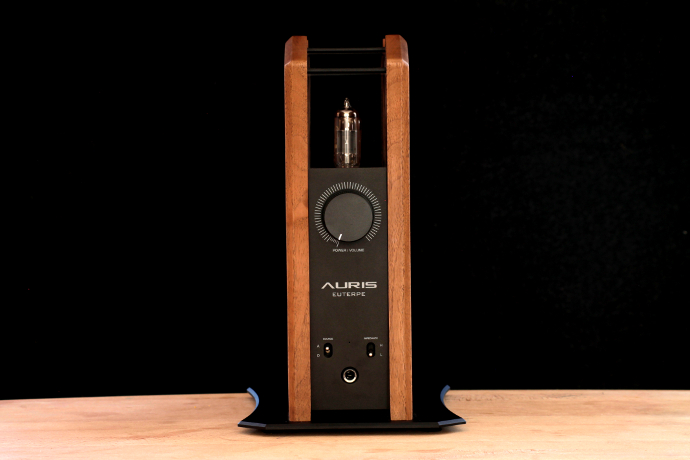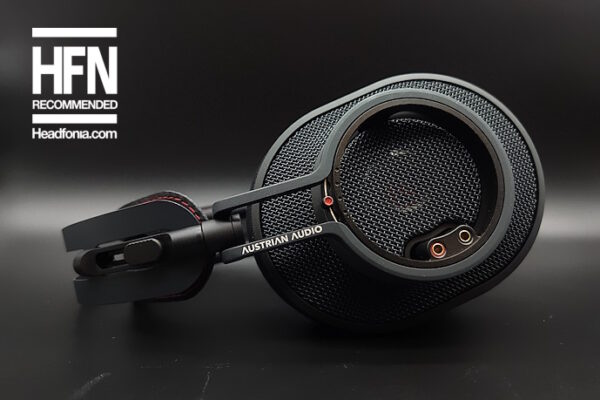Build Quality and Design:
Let me start by saying, pictures really don’t do the Euterpe justice. Especially not mine. Euterpe’s design is simple and elegant in my opinion, of course you’re free to disagree. Its walnut wooden sides are smoothly finished and give a sleek impression. The amplifier itself is nicely thin and compact in form-factor. Of course it doesn’t look like your average box of an amp. It’s different. At the same time, it makes the Euterpe recognizable. Maybe you’re aware, but Auris did not come up with that design themselves. It was “borrowed” from Kennerton and their Atlas amplifier. Auris even gives credit to Valentin of Kennerton for that on their website. Euterpe’s design makes it moonlight as a headphone stand as well, so you’re always ready to put your cans on and start listening with Euterpe.
Whenever I’m getting another piece of desktop equipment, my girlfriend usually isn’t overly thrilled. But with Euterpe it was a little different. We have a lot of wooden furniture in our apartment, and Euterpe does fit in very nicely. So much, that even my girlfriend said she likes it. Audio takes home a win, for once!
From a build quality perspective I find Euterpe to almost fully convince. Corners are rounded and smooth. Euterpe stands solidly on its metal base. The only problem I’m having with Euterpe is with its volume potentiometer. Personally, I prefer one that doesn’t turn that easily. I like some extra rigidity to fine-tune the volume levels more precisely. With Euterpe I feel it is rotating too easily. I have been informed by Auris, that this issue has been addressed and corrected in the meantime. So all new units will have tighter volume potentiometers.
Control:
Using Euterpe is pretty much straight forward. There’s one thing to look out for though. To turn on your new amplifier, you first need to turn on its power supply. The PSU comes with its own on/off switch. Unless you flick that, you won’t hear a single thing out of your Euterpe. You will also have to turn the volume knob clock-wise until it makes a click. This is the final step of delivering power to your amp.
Once you’ve done that, you’ll notice that Euterpe has a flashing red light on front. This is basically a 30 second count-down to let the tubes warm up a bit. Tubes usually take a good hour to fully warm up in my experience.
On the front you have two dip-switches. The left one is labelled “Source”, the right one “Impedance”. The source switch lets you pick between A (analogue, RCA) and D (digital, USB B) input. The impedance switch gives you more or less output impedance. Depending on the position you get higher (H), or lower (L) impedance. The low setting is recommended for headphones with 32-80 Ohms, and the high setting for headphones north of 150 Ohms. I found them to make a noticeable difference.
The top of the unit bears another switch, which gives you the opportunity to use EL95 tubes with the Euterpe. Since most EL95 and PL95 tubes are almost identical, there shouldn’t be much difference in audio though. Only a test can prove or disprove that. The biggest difference between the EL95 and PL95 tubes is the higher voltage of the EL (6.3V vs. 4.5V). This means you could harm your PL95 tubes with the EL95 setting of Euterpe.
Like any tube amp, Euterpe’s valves do get hot when using. The heat-dissipation of it however makes sure, that there is enough air-flow to keep the unit itself rather cool. Most warmth dissipates on top. It goes without saying, don’t touch the tubes when the unit is running. If you want to change the tubes, make sure they’re cooled down. You don’t want to burn your fingers. While tube-rolling always be careful when you’re taking the tubes out. These things are sensible.
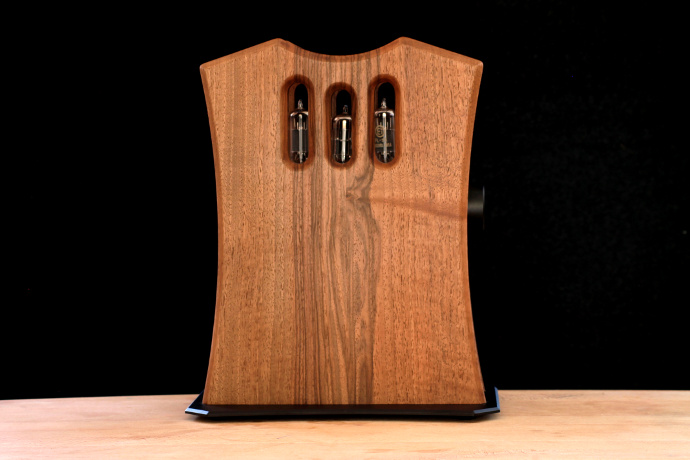
Auris Audio Euterpe
I listen to music at lower volumes, because I don’t want to blast my ears. Sound-output starts a bit before 9 o’clock. Shortly after 9 on the dial, channels will be balanced. Before that I’m getting some imbalance.
Sound:
One thing many tube amplifiers suffer from is noise. When using the Euterpe I was pleasantly surprised that even with sensitive headphones there wasn’t any to hear. I wouldn’t plug in hyper-sensitive IEMs, but monitors like the Trinity by Jomo Audio or 64 Audio’s Fourté Noir are running super quiet. The higher output impedance of Euterpe does skew the signatures of most IEMs away though. In Ears with a flat impedance curve, like newer 64 Audio products with LID, are fine.
I have mostly used Euterpe as analogue only amplifier, being coupled with the impressive Chord Electronics Qutest taking over DAC duties. We will go over the amp-only section of Euterpe before we cover its internal DAC section.
Euterpe is surprisingly neutral and balanced for a tube amplifier. Typical valve amps feature a lush, heavy and full sound, while Euterpe does so only to some extend. It does have some warmth in its sound, but the midrange is not particularly thick like I’m used to from previous tube amplifiers I have encountered.
The bass has good control and excellent body and texture. It is of calmer and softer nature, that sports great density. Bass goes deep with fine extension. Mid and upper bass are a bit elevated and stand out from the line. Low ends overall have nice dynamics and a rather organic tonality.
Lower midrange does get a touch of a boost from the upper bass segment, making them a bit more pronounced and warmer. This comes into play especially with male vocals, where they get more physicality. Vocals come with superb emotions, where there is enough air in them, to not sound static.
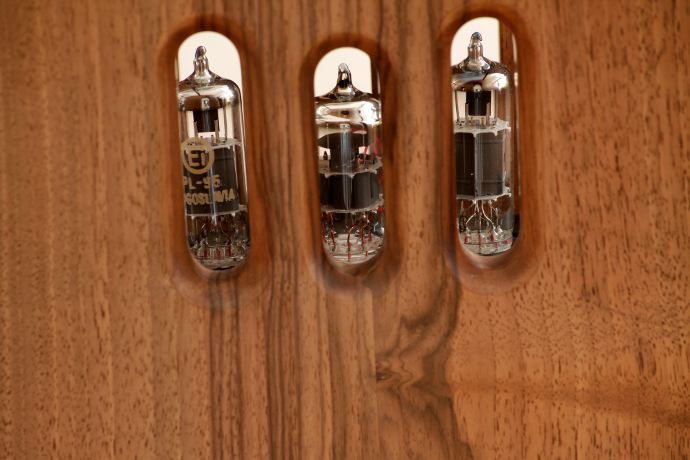
Auris Audio Euterpe
Instruments sound organic and realistic. There’s good flesh on the bones and very nice energy in the mids. Typically tube-amps have a super rich tonality, which is not as present on the Euterpe than on others. Still, the Auris does pack enough of it to not be dry and cold. Upper mids have splendid body and weight. Mids have high precision and speed. In some e-guitar solos you get the real picture of Euterpe’s energetic manner.
Resolution in pure amp mode is very nice with great instrumental separation. This is mostly due to the fact, that Euterpe has a wonderfully dark background, where every musician gets solid spotlight. Imaging is sharp and precise. Euterpe creates a sound stage that is well structured. It goes fairly wide and deep out of your head. It won’t pull you out of the scene though, it portrays music closer to you. This is more obvious with intimate headphones, like the Empyrean. Euterpe has really good layering abilities in my opinion. It keeps things well organized and structured. It manages to capture many details and enables you to distinguish between separate instruments easily.
Treble is done tastefully. I can’t detect any sharpness or hard edges in the top segment of Euterpe at all. Highs are clear and have good shimmer, yes, but there’s not much grain in these notes. The Auris does have a certain softness in its treble tones, that makes them really pleasing to the ear. At least to my set of ears.
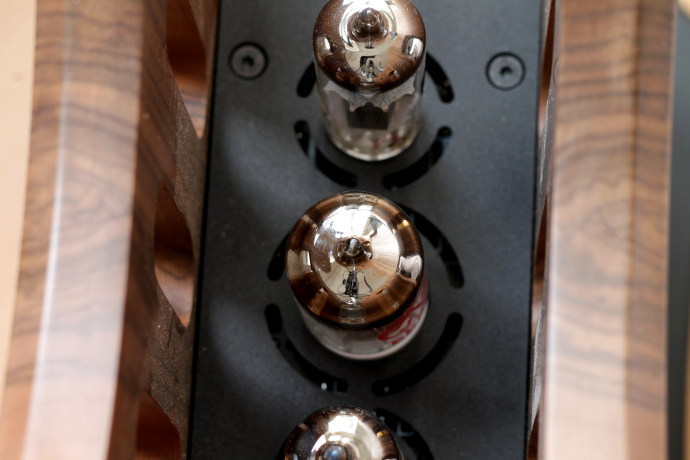
Auris Audio Euterpe
DAC Section
When switching from Qutest to the internal DAC one thing is rather obvious. The sound does get extra sweetness. Euterpe’s DAC section does a good job at reproducing details and spitting out information, however it can’t hold a candle against the power of a high end DAC like the Qutest.
With the internal DAC you get a more intimate presentation. The sound stage does not excel as wide or deep as with the Qutest. The overall sound is more focussed and not as wide-spread. Notes seem a touch richer and a little fuller as well to me. The presentation is a smoother one with a more relaxed sound.
Resolution, instrumental separation and layering all have taken a step back. With the internal DAC you get a dark background, but it’s not black like in amp-only mode. The sound is more two-dimensional, with good, but not excellent, imaging. Also, there seems to be some mild audible distortion, which is a big no-no. With Qutest Euterpe plays cleaner, clearer and with higher resolution. It separates sharper, extends wider and deeper and overall just performs at higher quality.
When using USB B input you also need to dial higher on the volume potentiometer.
More about Euterpe’s performance on the next page.





